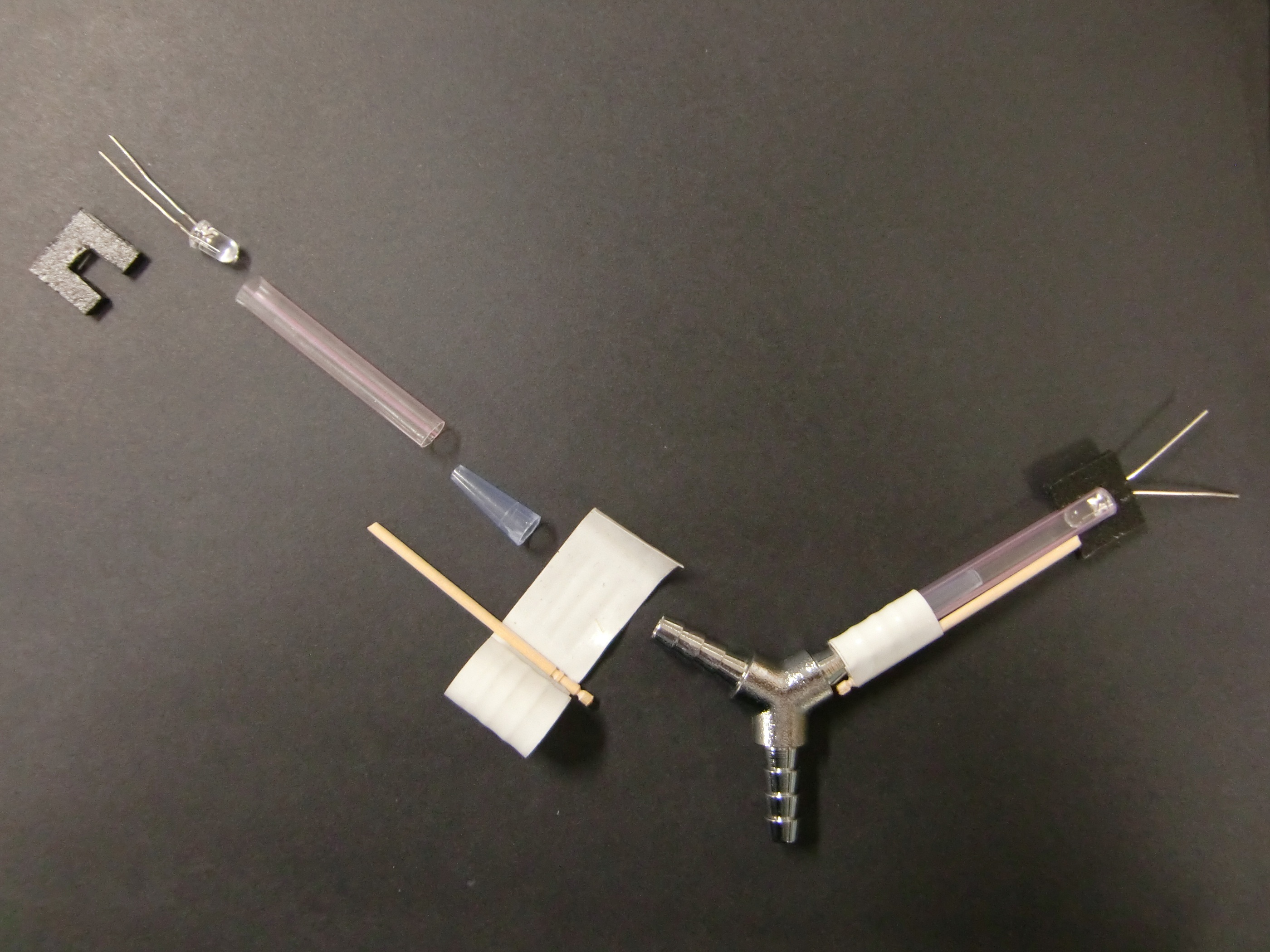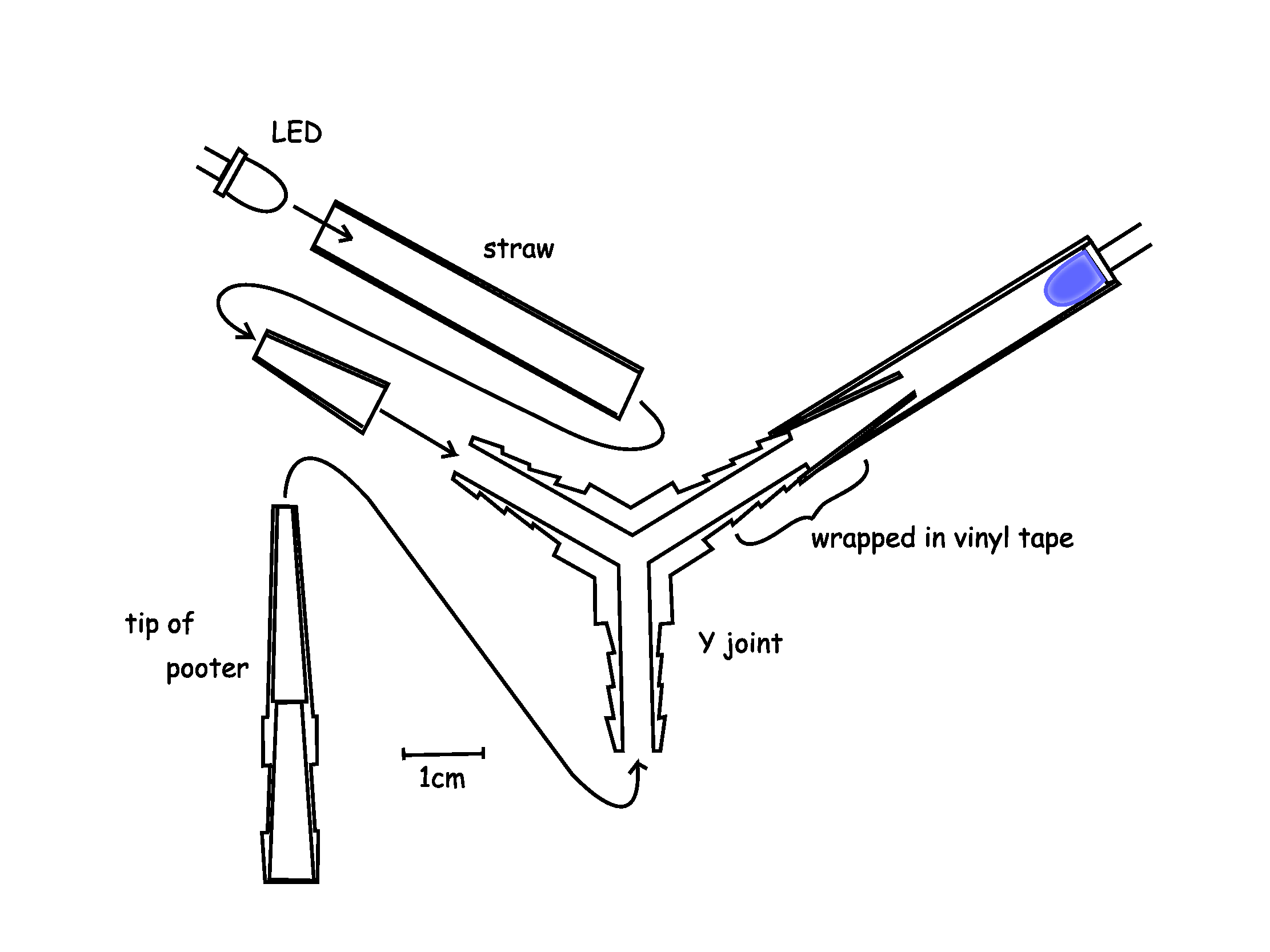Team:Kyoto/Capture
From 2011.igem.org
Grassfield (Talk | contribs) (→Y maze) |
Grassfield (Talk | contribs) (→Pooter(吸虫管)) |
||
| Line 45: | Line 45: | ||
ここにLED固定用の装置の寸法を記したイラスト/写真を載せる | ここにLED固定用の装置の寸法を記したイラスト/写真を載せる | ||
--> | --> | ||
| + | |||
====Pooter(吸虫管)==== | ====Pooter(吸虫管)==== | ||
| Line 58: | Line 59: | ||
When we move drosophilasfrom rearing bottles to the Y maze, we fitted the tip part with the tube part and draw some drosophilas into the tip part by mouth. Then closing the orifice of tip part by finger, we removed the tip part from the tube part and put it into the Y maze.(作成者:草場、未添削) | When we move drosophilasfrom rearing bottles to the Y maze, we fitted the tip part with the tube part and draw some drosophilas into the tip part by mouth. Then closing the orifice of tip part by finger, we removed the tip part from the tube part and put it into the Y maze.(作成者:草場、未添削) | ||
| - | [[File:Pooter photo.jpg|thumb|left| | + | [[File:Pooter photo.jpg|thumb|left|300px|Fig.3]] |
| - | [[File:Pooter illustration.png|thumb|left| | + | [[File:Pooter illustration.png|thumb|left|300px|Fig.4]] |
③使用中の写真 | ③使用中の写真 | ||
Revision as of 07:00, 4 October 2011
Contents |
Project Capture
Phototaxis of Drosophila melanogaster against lights of different wavelengths from --nm to --nm and weak luminescence emitted by Luxbrick(BBa_K325909, iGEM Cambridge2010) were evaluated. Drosophila melanogaster was chosen as the object for our research on insect's phototaxis because of its popularity among Japanese houses, the facility or easiness of it's breeding and it's genetical identity which results in the similar behavior. From the result of our research, Drosophila melanogaster was demonstrated to be a good ammoniacal source for genetically modified bacteria.
Introduction
In the nature, there are some organisms which lure insects. Rafflesia[http://en.wikipedia.org/wiki/Rafflesia] attracts flies by it's distinctive corrupt smell like rotting flesh. Pyrearinus termitilluminans, which makes and lives in a tunnel around the eternal surface of the anthill of termite Cornitermes cumulansand, emits light in the first week of the rainy season to lure and hunt the termites. Arachnocampa also uses light to hunt flies.
Escherichia coli is usually cultured in the rich nutrient medium because it originally lives in the gut of animals. However, this restriction can be overcome by genetic engineering. For the first step to make E.coli autotrophic, we resolved the problem of ammonia source. Many insects have some kinds of taxis. Taking advantage of their behaviors, we can enable E.coli to catch insects. The taxis of moth toward the pheromone is one of the famous example of chemotaxis, but it is difficult to enable E.coli to synthesize complex compounds like pheromone. Thus, we chose phototaxis. Drosophila has been reported to have phototaxis. Our project targeted flies(Drosophila melanogaster) as the model ammoniacal source because of its popularity among Japanese houses, the facility or easiness of it's breeding and it's genetical identity which results in the similar behavior. We introduced to E.coli, the LuxBrick(BBa_K3225909) created by the iGEM 2010 Cambridge team to emit light in normal E. coli strains without the addition of any external substrate.
Although, it is well known that D. melanogaster is phototactic, it was not clear whether it is lured by the weak light especially emitted by E.coli. To confirm this, we first demonstrated the phototaxis with the Y maze experiment, with several LEDs. Y maze was put up vertically to gain the significant results employing the geotaxis of D. melanogaster.
目標:大腸菌を光らせ、その光にハエを寄せ付ける。
手法:まず、LEDの光に対するハエの走行性を観察。
水平面に垂直に立てた、Y字型のmazeにハエを雄雌別で5匹ずつ3分間走らせた。
LEDはmazeの二つのゴール地点のうち両方に設置した。そして片方だけ灯し、もう片方は無灯火にした状態でハエを投入した。
mazeを水平面に対して垂直にしたのは、ハエの走地性を利用して明確な実験結果を得るためである。
その観察結果から、確かに大腸菌から発せられる495nm付近の波長にハエは引きつけられることが確認できた。
2010年のCambridgeによる研究の手法を使い光る大腸菌を作り、その光にハエをひきつける。
Materials and Methods
1. Apparatus
Y maze
Y maze was constructed by a Y joint, 弁, straws and LEDs.弁 was made of a blue tip of pipetman and it had the function to prevent drosophilas to go backward. Straws and 弁 were fitted with the two terminals of Y joint by vinyl tape as figure.LEDs were fitted with the other terminals of the straws by 凹-form parts made of polyethylene board. The angles of Y-form was 120°.
This Y maze is put into the dark room. (作成者:草場、未添削)
Pooter(吸虫管)
A pooter is very useful tool to move drosophilas. We also used it to move them from rearing bottles to the Y maze.
Our pooter consisted of two parts: tube part and tip part. The tube part was made of vinyl tube and two cutted tips of pipetman. The cutted tips were fitted with the terminals of tube by vinyl tape as mouthpiece and objective end. The tip part was made of two cutted tips of pipetman and a piece of tissue paper. Not to inhale drosophilas into the mouth, the piece of tissue paper was slipped in between the cutted tips.
When we move drosophilasfrom rearing bottles to the Y maze, we fitted the tip part with the tube part and draw some drosophilas into the tip part by mouth. Then closing the orifice of tip part by finger, we removed the tip part from the tube part and put it into the Y maze.(作成者:草場、未添削)
③使用中の写真
2. Object
Fly
The flies were derived on _日付_ August 2011 from the _strain_ of Drosophila melanogaster kept in _場所_. They were maintained in the temperature controlled incubator at _℃ with a _h light phase(LD 時間:時間) and cultured in the ordinary glass bottle (cm high, cm in diameter)with _培地の名前_medium. The medium was produced according to the method in http://. Every day, the newly born flies were transferred to another bottle to control the postnatal day. The population size of the flies were between _to_.
E.coli
strain, gene, culture method, etc.
3. Method
ハエ5匹を吸虫管で取る。吸虫管チップ部を取り外し、Y mazeの下部に差し込み、取り付ける。暗黒下で3分間放置し、Y mazeのどちらの管に何匹入ったかをカウントした。実験は左のライトを点灯した場合を2回、右のライトを点灯した場合を2回測定した。オス5匹1セットを2組、メス5匹1セットを2組行い、ライト点灯側と反対側に入ったハエの数のそれぞれ合計をとり、カイ2乗検定を行った。(by 草場)
Result
カイ二乗検定を危険率5%で行った結果、紫外線、青色光、緑色光ではハエがライト点灯側に有意に多く寄ってきていたことが分かった。一方、赤色光、赤外線では有意な差は認められなかった。これは既に報告されている結果とも一致している。(←要文献)
9月26日に行った実験では、発光大腸菌による光でも有意な差を得ることはできなかった。(←要改善)
Discussion
Reference
1. Rafflesia. In Wikipedia Retrieved 6 September 2011 at 16:02., from http://en.wikipedia.org/wiki/Rafflesia[1](※引用の方法あってるのか自信がない)
 "
"











